The election has been called, who’s being targeted?
Share

Over the weekend, Australian Prime Minister Scott Morrison called the anticipated Federal Election. Now, two months out, campaigning is sure to ramp up. Where will you be targeted?
Gone are the days of campaign canvassing. Flyers dropped all over the floor, littering train stations and public areas. If you’re voting in a safe seat for the election, you could be forgiven for forgetting it’s even happening. However, if you’re in a swinging seat, prepare to be targeted on every platform.
Traditional campaigning
From billboards to pamphlets, traditional campaigning is still part of anyone going for office. Knock on the door candidates still do the rounds. Finding out what it is that you’re looking for in a local candidate is key to campaign messaging.
However, this won’t be an election ran off what we used to know about political advertising. The messaging will come to you constantly. At home, at work, on the commute.
Digital campaigning will be the powerhouse in the lead up to the 2022 Federal Election.
Digital footprint
As is well known, as consumers we are constantly being targeted by ads and services directly to our interests and habits. But, for political campaigning, it’s a little different.
Still using online footprints, political parties can and will campaign by demographics. Age, location, gender. Google has limited the targets normally allowed, so that the messaging isn’t specific to needs or manipulative to certain audiences.
Advertisers can also serve ads on Google’s ad network based on the behaviours that someone has online. Following what content they consume, this technique is known as contextual target. So, if someone has been consuming a lot of content based around climate change, then it can be assumed that these voters will be given content around battling climate change from the different political parties.
Who is doing what?
The Liberal Party and the Labor Party are being unsurprisingly private about the advertising tactics. Holding cards this close to the chest comes as no surprise, as the public already possess political scepticism. The Greens’ have announced that no contextual and behavioural targeting will be used.
Controversial figure Clive Palmer is taking a slightly different approach. Rather than ads targeted to specific pockets and swinging seats, Palmer is using a more shotgun approach. In fact, you’d be hard pressed to find someone who hadn’t seen a YouTube ad or a billboard with the United Australia Party’s (UAP) distinct yellow. The party, headed by Palmer, has spent millions of dollars in the lead-up to the 2022 election. His demographic? Australia.
Digital campaigning has been happening for a long time. However, the capabilities have increased. In the short run time given to the lead up to 2022’’s Federal Election, all eyes will be on who wins, and the eyes of those competing are also back on us – the voters.















